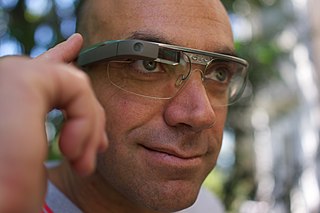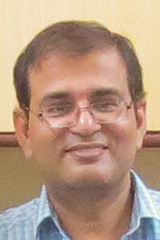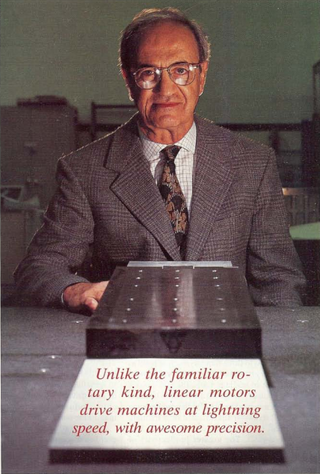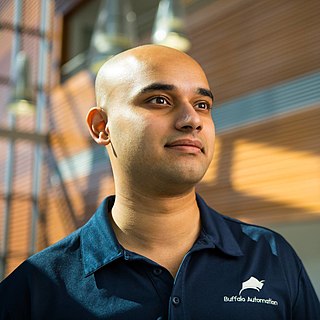Computer vision tasks include methods for acquiring, processing, analyzing and understanding digital images,and extraction of high-dimensional data from the real world in order to produce numerical or symbolic information, e.g. in the forms of decisions. Understanding in this context means the transformation of visual images into descriptions of the world that make sense to thought processes and can elicit appropriate action. This image understanding can be seen as the disentangling of symbolic information from image data using models constructed with the aid of geometry, physics, statistics, and learning theory.

An optical mouse is a computer mouse which uses a miniature camera and digital image processing to detect movement relative to a surface. Variations of the optical mouse have largely replaced the older mechanical mouse and its need for frequent cleaning.

Machine vision is the technology and methods used to provide imaging-based automatic inspection and analysis for such applications as automatic inspection, process control, and robot guidance, usually in industry. Machine vision refers to many technologies, software and hardware products, integrated systems, actions, methods and expertise. Machine vision as a systems engineering discipline can be considered distinct from computer vision, a form of computer science. It attempts to integrate existing technologies in new ways and apply them to solve real world problems. The term is the prevalent one for these functions in industrial automation environments but is also used for these functions in other environment vehicle guidance.
Cognex Corporation is an American manufacturer of machine vision systems, software and sensors used in automated manufacturing to inspect and identify parts, detect defects, verify product assembly, and guide assembly robots. Cognex is headquartered in Natick, Massachusetts, USA and has offices in more than 20 countries.
Document processing is a field of research and a set of production processes aimed at making an analog document digital. Document processing does not simply aim to photograph or scan a document to obtain a digital image, but also to make it digitally intelligible. This includes extracting the structure of the document or the layout and then the content, which can take the form of text or images. The process can involve traditional computer vision algorithms, convolutional neural networks or manual labor. The problems addressed are related to semantic segmentation, object detection, optical character recognition (OCR), handwritten text recognition (HTR) and, more broadly, transcription, whether automatic or not. The term can also include the phase of digitizing the document using a scanner and the phase of interpreting the document, for example using natural language processing (NLP) or image classification technologies. It is applied in many industrial and scientific fields for the optimization of administrative processes, mail processing and the digitization of analog archives and historical documents.

Laser guidance directs a robotics system to a target position by means of a laser beam. The laser guidance of a robot is accomplished by projecting a laser light, image processing and communication to improve the accuracy of guidance. The key idea is to show goal positions to the robot by laser light projection instead of communicating them numerically. This intuitive interface simplifies directing the robot while the visual feedback improves the positioning accuracy and allows for implicit localization. The guidance system may serve also as a mediator for cooperative multiple robots. Examples of proof-of-concept experiments of directing a robot by a laser pointer are shown on video. Laser guidance spans areas of robotics, computer vision, user interface, video games, communication and smart home technologies.
Krishna Bharat is an Indian research scientist at Google Inc. He was formerly a founding adviser for Grokstyle Inc. a visual search company and Laserlike Inc., an interest search engine startup based on Machine Learning.
Alex Fielding is an American engineer and manager. He is the CEO and co-founder of Privateer Space, a space startup with a global online marketplace that aims to connect customers seeking planetary data with orbiting satellites and AI. He co-founded the company with Apple co-founder Steve Wozniak and MacArthur Genius Moriba Jah. Privateer announced in 2023 that it had grown the business from the Google Maps of space to become the first AI powered space data ride sharing platform with an upcoming satellite autopilot system called Pono set to fly on SpaceX in December 2023. The International Space Station National Labs, in partnership with Privateer announced a deal whereby Privateer publicly tracks and displays mission data on International Space Station telemetry, astronauts, and mission objectives live on the ISS National Labs website. He was co-founder and CEO of robotics company Ripcord, Inc from 2014 to 2021.
Object recognition – technology in the field of computer vision for finding and identifying objects in an image or video sequence. Humans recognize a multitude of objects in images with little effort, despite the fact that the image of the objects may vary somewhat in different view points, in many different sizes and scales or even when they are translated or rotated. Objects can even be recognized when they are partially obstructed from view. This task is still a challenge for computer vision systems. Many approaches to the task have been implemented over multiple decades.

Daniel Nicholas Quine is a computer scientist, currently VP Engineering at AltSchool.

Reverse image search is a content-based image retrieval (CBIR) query technique that involves providing the CBIR system with a sample image that it will then base its search upon; in terms of information retrieval, the sample image is very useful. In particular, reverse image search is characterized by a lack of search terms. This effectively removes the need for a user to guess at keywords or terms that may or may not return a correct result. Reverse image search also allows users to discover content that is related to a specific sample image or the popularity of an image, and to discover manipulated versions and derivative works.

An optical head-mounted display (OHMD) is a wearable device that has the capability of reflecting projected images as well as allowing the user to see through it. In some cases, this may qualify as augmented reality (AR) technology. OHMD technology has existed since 1997 in various forms, but despite a number of attempts from industry, has yet to have had major commercial success.

Peter Karow is a German entrepreneur, inventor and software developer. He holds several patents in the field of desktop publishing and is known for his work on computer fonts. He contributed with several books and patents to the development of operating systems for computers. He is recognized as the inventor of outline computer fonts.

Subhasis Chaudhuri is an Indian electrical engineer and former director at the Indian Institute of Technology, Bombay. He is a former K. N. Bajaj Chair Professor of the Department of Electrical Engineering of IIT Bombay. He is known for his pioneering studies on computer vision and is an elected fellow of all the three major Indian science academies viz. the National Academy of Sciences, India, Indian Academy of Sciences, and Indian National Science Academy. He is also a fellow of Institute of Electrical and Electronics Engineers, and the Indian National Academy of Engineering. The Council of Scientific and Industrial Research, the apex agency of the Government of India for scientific research, awarded him the Shanti Swarup Bhatnagar Prize for Science and Technology, one of the highest Indian science awards, in 2004 for his contributions to Engineering Sciences.
Ashutosh Saxena is an Indian-American computer scientist, researcher, and entrepreneur known for his contributions to the field of artificial intelligence and large-scale robot learning. His interests include building enterprise AI agents and embodied AI. Saxena is the co-founder and CEO of Caspar.AI, where generative AI parses data from ambient 3D radar sensors to predict 20+ health & wellness markers for pro-active patient care. Prior to Caspar.AI, Ashutosh co-founded Cognical Katapult, which provides a no credit required alternative to traditional financing for online and omni-channel retail. Before Katapult, Saxena was an assistant professor in the Computer Science Department and faculty director of the RoboBrain Project at Cornell University.
Jiebo Luo is a Chinese-American computer scientist, the Albert Arendt Hopeman Professor of Engineering and Professor of Computer Science at the University of Rochester. He is interested in artificial intelligence, data science and computer vision.
Jannick Rolland is the Brian J. Thompson Professor of Optical Engineering at the Institute of Optics at the University of Rochester. She is also the co-founder and CTO of LighTopTech, a women-owner business founded in 2013 to create medical imaging technologies with biomimetic noninvasive imaging technology. At the University of Rochester, she is the Director of the NSF I/UCRC Center for Freeform Optics (CeFO). She is also the Director of the R.E. Hopkins Center for Optical Design and Engineering that engages undergraduates in optical design, fabrication, and metrology.

Anwar Chitayat is the founder and former CEO and chairman of Anorad Corp., which was acquired in 1998 by Rockwell Automation. Mr. Chitayat holds over 95 patents in Electronics, Semiconductors and Automation including Nanotechnology, Interferometry and Linear motors. His achievements in High technology were honored by SEMI in 2000 at their highest honor for Lifetime Achievement, reserved for individuals who repeatedly enable and lead the technology industry throughout their professional career. In 1997, Anwar was awarded the Entrepreneur of the year award by Ernst and Young, and in 2009, Anwar was inducted to Long Island Hall of Fame for his impacts on science and technology on Long Island.

Thiru Vikram is an inventor, engineer and entrepreneur, who is the CEO of Buffalo Automation, a technology company headquartered in Buffalo, New York, that provides autonomous navigation technology for commercial ships and recreational boats.
Video matting is a technique for separating the video into two or more layers, usually foreground and background, and generating alpha mattes which determine blending of the layers. The technique is very popular in video editing because it allows to substitute the background, or process the layers individually.









